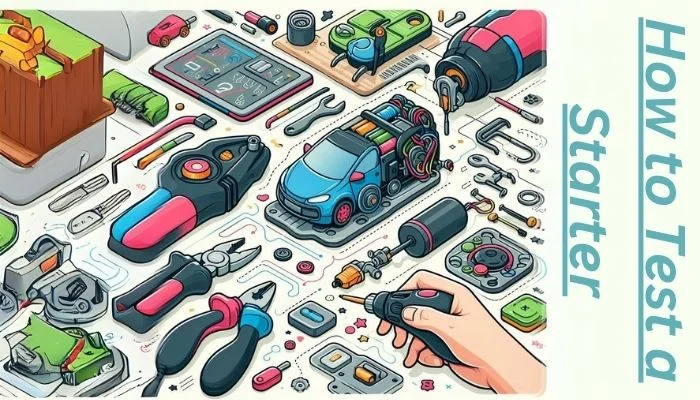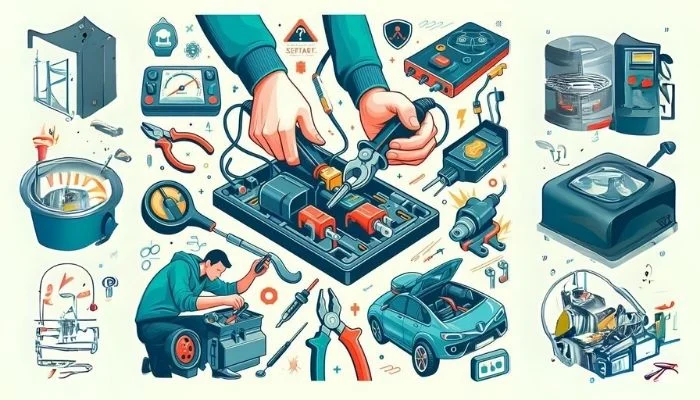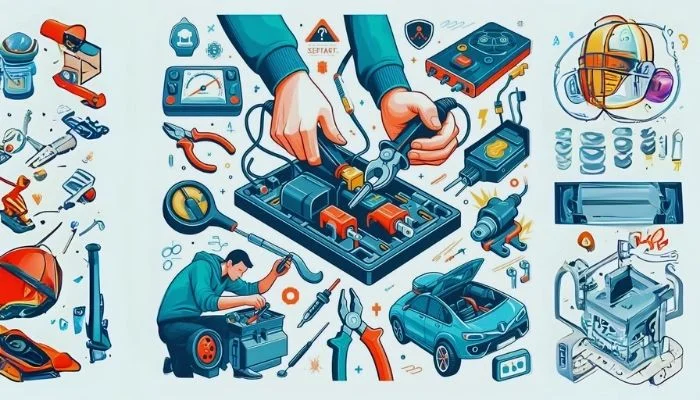Is your vehicle’s starter acting up? Experiencing sluggish cranking, clicking noises, or even complete failure? Don’t let a faulty starter disrupt your daily routine. In this comprehensive guide, we’ll walk you through the step-by-step process of testing your starter, empowering you to diagnose and potentially resolve the issue yourself. With clear instructions and expert advice, you’ll be back on the road in no time.
Key Takeaways:
- A starter is a crucial component of a vehicle’s engine, responsible for initiating the combustion process.
- Regular testing is essential to prevent unexpected breakdowns and ensure smooth operation.
- Common starter problems include slow cranking, no cranking, clicking noises, and burning smells.
- Basic tools like a test light, multimeter, and ratchet and socket set are necessary for testing.
- Visual inspection, battery testing, starter solenoid testing, and starter motor testing are key steps in diagnosing issues.
- Understanding the types of starters and their specific testing procedures is crucial for accurate troubleshooting.
Introduction
A starter is a vital component of a vehicle’s engine, responsible for initiating the combustion process. It is essentially a powerful electric motor that converts electrical energy into mechanical energy, turning the crankshaft and enabling the engine to start. Regular testing of your starter is crucial to prevent unexpected breakdowns and ensure smooth operation.
Understanding Starters
Before exploring the testing process, it’s essential to have a basic understanding of the different types of starters commonly found in vehicles:
- Gear Reduction Starters: These are the most common type, featuring a gear reduction mechanism that increases torque and allows for a smaller, lighter motor.
- Permanent Magnet Starters: These starters utilize permanent magnets instead of electromagnets, resulting in improved efficiency and reduced weight.
- Solenoid-Operated Starters: These starters rely on a solenoid to engage the starter motor, providing a simple and reliable mechanism.
Common Starter Problems
Identifying common starter problems can help narrow down the potential causes and expedite the troubleshooting process. Some of the most frequently encountered issues include:

- Slow Cranking: This can be caused by a weak battery, faulty starter solenoid, or problems with the starter motor itself.
- No Cranking: This could be due to a dead battery, faulty starter solenoid, or issues with the starter motor.
- Clicking Noise: A clicking noise often indicates a problem with the starter solenoid or a weak battery.
- Burning Smell: This can be a sign of overheating, which may be caused by a faulty starter motor or excessive current draw.
Essential Tools and Equipment
To effectively test a starter, you’ll need the following tools and equipment:
- Test Light: Used to check for power and continuity in electrical circuits.
- Multimeter: Measures voltage, current, and resistance.
- Ratchet and Socket Set: Used to remove and reinstall components.
- Screwdriver: For disassembling and reassembling parts.
- Battery Charger: For charging the vehicle’s battery if necessary.
Step-by-Step Testing Procedures
Now that you have a solid foundation, let’s delve into the step-by-step process of testing a starter:
1. Visual Inspection
- Begin by visually inspecting the starter for any obvious signs of damage, loose wires, or corrosion.
- Check the starter solenoid, brushes, and commutator for wear or damage.
- Look for any signs of overheating or burning.
2. Battery Testing
- Use a multimeter to measure the voltage of the vehicle’s battery.
- A healthy battery should have a voltage of around 12.6 volts.
- If the battery voltage is low, charge it and retest.
- While the starter is engaged, check for a voltage drop across the battery terminals. A significant voltage drop indicates a problem with the battery or the starter circuit.
3. Starter Solenoid Testing
- Use a test light to check for power at the starter solenoid’s terminals.
- If there is no power, inspect the wiring and fuses leading to the solenoid.
- Test the solenoid’s contacts for continuity using a multimeter.
- If the solenoid is faulty, it will need to be replaced.
4. Starter Motor Testing
- Disconnect the battery negative terminal.
- Use a jumper cable to connect the positive terminal directly to the starter’s positive terminal.
- Observe the starter’s operation and listen for any unusual noises.
- If the starter spins freely and without noise, the problem likely lies in the wiring or control circuitry.
- If the starter is slow or does not spin, it may be faulty and require replacement.
Additional Troubleshooting Tips

- Test the Starter Relay: If the starter relay is faulty, it can prevent the starter from engaging. Test the relay using a multimeter or by bypassing it with a jumper cable.
- Check for Voltage Drop in the Wiring Harness: A voltage drop in the wiring harness can hinder the starter’s performance. Inspect the wiring for any damage or corrosion.
- Consider Environmental Factors: Extreme temperatures or excessive moisture can affect the starter’s operation. Ensure the starter is properly protected from the elements.
Understanding Starter Components
To gain a deeper understanding of starter testing, it’s essential to familiarize yourself with the key components that make up a starter:
- Starter Motor: The heart of the starter, it converts electrical energy into mechanical energy to turn the crankshaft.
- Starter Solenoid: A magnetic switch that activates the starter motor when energized.
- Brushes and Commutator: Components that provide electrical contact between the starter motor’s windings and the external power source.
- Field Windings: Coils of wire that create a magnetic field when energized, causing the starter motor to rotate.
- Armature: The rotating part of the starter motor, containing the field windings.
Advanced Testing Techniques
In addition to the basic testing procedures outlined in Part 1, more advanced techniques can be employed to pinpoint specific issues:
- Resistance Testing: Use a multimeter to measure the resistance of the starter motor’s windings. Excessive resistance can indicate a faulty winding or internal short circuit.
- Current Testing: Monitor the current draw of the starter motor while it is operating. Excessive current consumption can be a sign of a faulty component or mechanical problem.
- Compression Testing: Check the engine’s compression to ensure it is within the manufacturer’s specifications. Low compression can make it difficult for the starter to turn the crankshaft.
Starter Maintenance
Regular maintenance is crucial to prolong the life of your starter and prevent unexpected breakdowns. Here are some essential maintenance tips:

- Inspect for Corrosion: Regularly inspect the starter for signs of corrosion, especially on the terminals and wiring. Clean and tighten any corroded connections.
- Lubricate Moving Parts: Apply a small amount of grease to the starter’s moving parts, such as the brushes and commutator, to reduce friction and wear.
- Check Battery Condition: Ensure the vehicle’s battery is in good condition and properly charged. A weak battery can strain the starter and lead to premature failure.
- Avoid Overloading: Avoid overloading the starter by cranking the engine for extended periods. This can overheat the starter and damage its components.
You might also be interested in: How To Change Battery In Hyundai Key Fob: Quick Fix
Conclusion
By understanding the components, testing procedures, and maintenance practices associated with starters, you can effectively troubleshoot and address any issues that may arise. Remember to prioritize safety and consult a professional mechanic if you are unsure or uncomfortable with any of the procedures. With proper care and maintenance, your starter will provide reliable service for many years to come.
Frequently Asked Questions
How often should I test my starter?
It is recommended to test your starter at least once a year or if you notice any unusual symptoms.
Can I replace a starter myself?
While it is possible to replace a starter yourself, it requires mechanical skills and specialized tools. If you are unsure, it is best to consult a professional mechanic.
What are the signs of a bad starter?
Common signs of a bad starter include slow cranking, no cranking, clicking noises, burning smells, or excessive current draw.
How much does it cost to replace a starter?
The cost of replacing a starter varies depending on the vehicle’s make and model, as well as the labor costs in your area. However, it is generally a significant expense.
How do you test a starter?
To test a starter, you’ll need a voltmeter and a test light. First, check the battery voltage. If it’s low, charge or replace it. Next, test the starter solenoid. If it’s not clicking, check the connections and fuses. Finally, test the starter motor itself. If it doesn’t spin, it’s likely faulty.
How does a starter work step by step?
A starter works in three main steps: 1) The ignition switch activates the starter solenoid. 2) The solenoid engages a gear that meshes with the flywheel. 3) The starter motor spins the flywheel, turning the engine.
What is the first step in diagnosing a starter?
The first step in diagnosing a starter is to check the battery voltage. A low battery voltage can prevent the starter from working properly.
What are the three tests performed on a starter system?
The three main tests performed on a starter system are: 1) Battery voltage test 2) Starter solenoid test 3) Starter motor test.
How to know if starter is bad or battery?
If the battery voltage is low, the starter might not be able to function. However, if the battery voltage is good and the starter still isn’t working, it’s likely a problem with the starter itself.
What is the basic principle of a starter?
The basic principle of a starter is to use an electric motor to spin the engine’s flywheel, allowing it to start.
